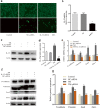IL-32 induces epithelial-mesenchymal transition by triggering endoplasmic reticulum stress in A549 cells
- PMID: 33097029
- PMCID: PMC7585222
- DOI: 10.1186/s12890-020-01319-z
IL-32 induces epithelial-mesenchymal transition by triggering endoplasmic reticulum stress in A549 cells
Abstract
Background: Epithelial-mesenchymal transition (EMT) is a key process in the onset and development of idiopathic pulmonary fibrosis (IPF) with unclear mechanisms. Our previous studies found that bleomycin and tunicamycin could induce ER stress and consequently trigger EMT accompanying with IL-32 overexpression. This study was aimed to investigate the effects of IL-32 on EMT and ER stress to elucidate the pathogenesis of IPF.
Methods: Human lung adenocarcinoma A549 cells were treated with recombinant human (rh)IL-32, IL-32 siRNA and EMT inducer tunicamycin, or 4-phenylbutyric acid (4-PBA), respectively. Then the cell morphology was observed and the expression of ER-related markers and EMT-related markers were detected by RT-qPCR or western blotting.
Results: Stimulation of A549 cells with rhIL-32 led to a morphological change from a pebble-like shape to an elongated shape in a portion of the cells, accompanied by down regulated expression of the epithelial cell marker E-cadherin and up regulated expression of the mesenchymal cell markers N-cadherin, Vimentin, and Zeb-1. However, these rhIL-32 induced changes were inhibited by the ER stress inhibitor 4-PBA. Suppression of IL-32 expression with siRNA inhibited TM-induced EMT. Further stimulation of the A549 cells with rhIL-32 demonstrated an increase in the expression of GRP78, although this increase was also inhibited by 4-PBA.
Conclusions: These results suggest that IL-32 induces EMT in A549 cells by triggering ER stress, and IL-32 may be a novel marker for IPF.
Keywords: Endoplasmic reticulum stress; Epithelial-mesenchymal transition; IL-32; Idiopathic pulmonary fibrosis.
Conflict of interest statement
None.
Figures





Similar articles
-
Histone Deacetylases Promote ER Stress Induced Epithelial Mesenchymal Transition in Human Lung Epithelial Cells.Cell Physiol Biochem. 2018;46(5):1821-1834. doi: 10.1159/000489367. Epub 2018 Apr 25. Cell Physiol Biochem. 2018. PMID: 29705800
-
Endoplasmic reticulum stress mediates nickel chloride-induced epithelial‑mesenchymal transition and migration of human lung cancer A549 cells through Smad2/3 and p38 MAPK activation.Ecotoxicol Environ Saf. 2023 Jan 1;249:114398. doi: 10.1016/j.ecoenv.2022.114398. Epub 2022 Dec 9. Ecotoxicol Environ Saf. 2023. PMID: 36508813
-
TGF-beta1 induces human alveolar epithelial to mesenchymal cell transition (EMT).Respir Res. 2005 Jun 9;6(1):56. doi: 10.1186/1465-9921-6-56. Respir Res. 2005. PMID: 15946381 Free PMC article.
-
Emerging evidence for endoplasmic reticulum stress in the pathogenesis of idiopathic pulmonary fibrosis.Am J Physiol Lung Cell Mol Physiol. 2012 Apr 15;302(8):L721-9. doi: 10.1152/ajplung.00410.2011. Epub 2012 Jan 27. Am J Physiol Lung Cell Mol Physiol. 2012. PMID: 22287606 Free PMC article. Review.
-
Non-coding RNAs and nuclear architecture during epithelial-mesenchymal transition in lung cancer and idiopathic pulmonary fibrosis.Cell Signal. 2020 Jun;70:109593. doi: 10.1016/j.cellsig.2020.109593. Epub 2020 Mar 2. Cell Signal. 2020. PMID: 32135188 Review.
Cited by
-
Unraveling the Role of Bromodomain and Extra-Terminal Proteins in Human Uterine Leiomyosarcoma.Cells. 2024 Aug 28;13(17):1443. doi: 10.3390/cells13171443. Cells. 2024. PMID: 39273015 Free PMC article.
-
A Novel Defined Endoplasmic Reticulum Stress-Related lncRNA Signature for Prognosis Prediction and Immune Therapy in Glioma.Front Oncol. 2022 Jun 30;12:930923. doi: 10.3389/fonc.2022.930923. eCollection 2022. Front Oncol. 2022. PMID: 35847925 Free PMC article.
-
Effective Drug Concentration and Selectivity Depends on Fraction of Primitive Cells.Int J Mol Sci. 2021 May 6;22(9):4931. doi: 10.3390/ijms22094931. Int J Mol Sci. 2021. PMID: 34066491 Free PMC article.
-
Precise identification of cell states altered in disease using healthy single-cell references.Nat Genet. 2023 Nov;55(11):1998-2008. doi: 10.1038/s41588-023-01523-7. Epub 2023 Oct 12. Nat Genet. 2023. PMID: 37828140 Free PMC article.
-
Unraveling the Molecular Nexus between GPCRs, ERS, and EMT.Mediators Inflamm. 2021 Mar 2;2021:6655417. doi: 10.1155/2021/6655417. eCollection 2021. Mediators Inflamm. 2021. PMID: 33746610 Free PMC article. Review.
References
MeSH terms
Substances
Grants and funding
- [2018]5623/Guizhou Provincial Natural Science Foundation Project
- [2020]4Y121/Guizhou Provincial Natural Science Foundation Project
- [2019]69/Zunyi Respiratory Medicine Talent Base Project
- [2020]1/Research and Experimental Development plan of the first People's Hospital of Zunyi
- [2020]15/Research and Experimental Development plan of the first People's Hospital of Zunyi
LinkOut - more resources
Full Text Sources
Research Materials
Miscellaneous

